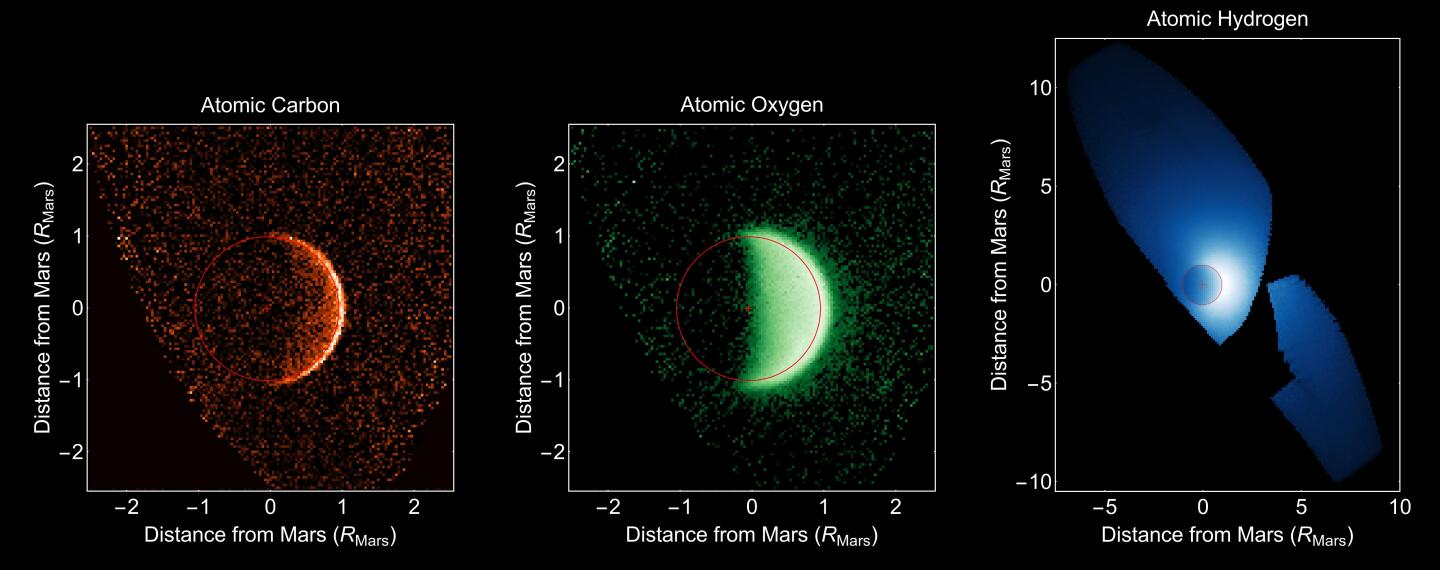After completing its 10 month-long voyage, NASA's Mars Atmosphere and Volatile Evolution (MAVEN) spacecraft is taking its first look at the Martian atmosphere. Part of the unmanned orbiter’s commissioning phase, it limbered up its sensors by observing the effect of a massive solar event and returned its first images of the fountain-like coronas that are slowly peeling away the Red Planet's atmosphere.
Launched in November of last year from Cape Canaveral, Florida, MAVEN arrived at Mars on September 21 and has since moved to a lower orbit. Its first observations included taking ultraviolet images of the tenuous oxygen, hydrogen, and carbon coronas in the upper atmosphere, and creating a comprehensive map of its ozone layers. During this process, NASA scientists say that the instruments are working better than expected.
MAVEN’s main mission is to study the effect of the Sun on the Martian atmosphere and has hit the ground running. On September 26, a flare erupted from the Sun, arriving at Mars on the 29th, where it was observed by MAVEN's Solar Energetic Particle instrument. These events occur at irregular intervals and scientists believe that they are a major reason why the Martian atmosphere is so tenuous. Energetic solar particles are powerful enough to strip away air molecules. Earth's magnetic field protects us from this, but the Martian magnetic field is extremely weak and spotty.

As part of this study of how Mars lost its atmosphere, MAVEN’s Imaging Ultraviolet Spectrograph (IUVS) is looking at fountain-like coronas in the Martian upper atmosphere, where hydrogen and oxygen atoms produced by the break up of water and carbon dioxide are boosted to high altitudes and lost to space on a continual basis. NASA hopes that understanding this mechanism will not only give a better picture of the history of Mars, but also help explain why the planet is so different from Venus and Earth.
In addition, MAVEN is also building up a comprehensive map of ozone in the atmosphere.
"With these maps we have the kind of complete and simultaneous coverage of Mars that is usually only possible for Earth," says MAVEN remote sensing team member Justin Deighan of the University of Colorado, Boulder. "On Earth, ozone destruction by refrigerator CFCs is the cause of the polar ozone hole. On Mars, ozone is just as easily destroyed by the byproducts of water vapor breakdown by ultraviolet sunlight. Tracking the ozone lets us track the photochemical processes taking place in the Martian atmosphere. We'll be exploring this in more complete detail during MAVEN's primary science mission."
MAVEN's commissioning includes another fortnight of instrument testing and a data transmission test with the Curiosity rover using MAVEN as a relay. If these prove successful, the orbiter's science mission will begin in November. Though MAVEN's first observations were merely preliminary, NASA says that its a taste of what's to come when all the spacecraft's sensors are online.
The video below discusses MAVEN’s first look at Mars.
Source: NASA






